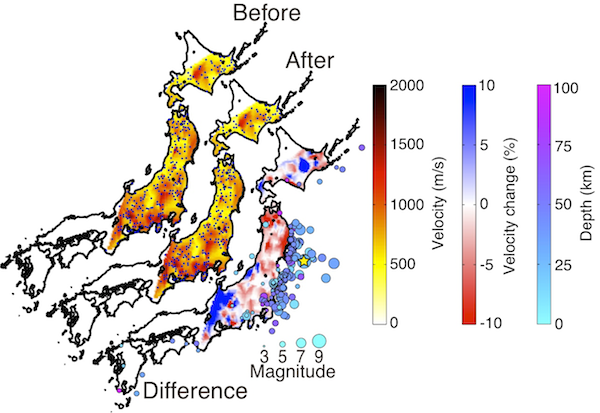2012 IRIS Workshop
Near-surface Weakening in Japan after the Tohoku-Oki Earthquake on March 11, 2011
Nori Nakata: Colorado School of Mines, Roel Snieder: Colorado School of Mines
Average shear-wave velocities over two time periods: January 1 – March 10 in 2011 (before the Tohoku-Oki earthquake: top map) and March 12 – May 26 in 2011 (after the main shock: middle map). Blue dots on these two maps show the KiK-net stations. The bottom map gives the relative change in shear-wave velocity after the event. The size of each circle indicates the magnitude of each earthquake and the color represents the depth. The yellow star denotes the location of the Tohoku-Oki earthquake.

Full-resolution graphics file in original format: 0025.jpg
The magnitude (Mw) 9.0 Tohoku-Oki earthquake on March 11, 2011 was one of the largest in recent history. Ground motion caused by the seismicity around the time of the main shock was recorded by KiK-net, the strong-motion network that covers most of Japan. About 700 KiK-net stations are distributed across Japan, and each station has a borehole, a few hundred meters deep, with seismographs at the bottom and top of the borehole. By applying deconvolution-based seismic interferometry to the ground motion, in which we deconvolve the seismogram at a top receiver with that at a bottom receiver, we retrieve the shear wave propagating from the bottom sensor to the top sensor at each station. From this, we estimate the shear-wave velocity in the near surface by finding the travel time of the interferometric waveform (Nakata and Snieder, 2012). At a station, we detect a reduction of shear-wave velocity in the upper 100 m of about 10%, and a subsequent healing that varies logarithmically with time (Nakata and Snieder, 2011). Using all available borehole and surface records of more than 300 earthquakes that occurred between 1 January 2011 and 26 May 2011, we observe a reduction in the shear-wave velocity of about 5% in the upper few hundred meters after the Tohoku-Oki earthquake throughout northeastern Japan (Nakata and Snieder, 2011: figure). The area of the velocity reduction is about 1,200 km wide, which is much wider than earlier studies reporting velocity reductions following other larger earthquakes. The reduction of the shear-wave velocity is an indication that the shear modulus, and hence the shear strength, is reduced over a large part of Japan.
Acknoweldgements: We are grateful to the national research institute of earth science and disaster prevention (NIED) for providing us with the earthquake data.
For further reading: Nori Nakata and Roel Snieder (2011), Near-surface weakening in Japan after the 2011 Tohoku-Oki earthquake, Geophys. Res. Lett., 38, L17302. Nori Nakata and Roel Snieder (2012), Estimating near-surface shear-wave velocities in Japan by applying seismic interferometry to KiK-net data, J. Geophys. Res., 117, B01308. doi: "10.1029/2011GL048800,
Keywords: shear-wave_velocity, near_surface, tohoku-oki_earthquake, seismic_interferometry
